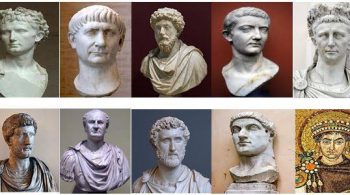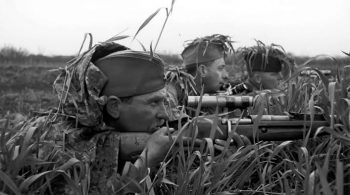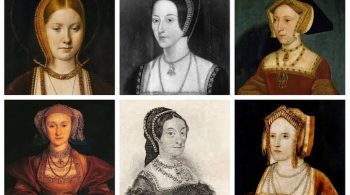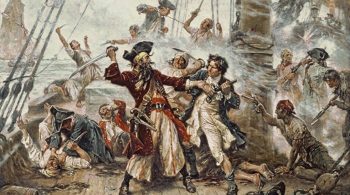The knights of medieval Europe were meant to be the finest fighting men of their age, even more important, they were expected to be pure in thought and deed, as exemplified in the chivalrous code which they (usually) followed. Here are the stories of 12 such knights. The legendary figures are perhaps based on historical knights and the historical knights have all become legendary; such is the indistinct line of truth between fact and fiction and humanity’s need to create larger-than-life figures of a by-gone age when valour and chivalry reached their apex.
Medieval Knights Armour
A knight needed to practise controlling his steed with only his knees and feet since he had to ride a horse while carrying a large, triangular leather and wood shield and a wooden lance that was 2.4-3.0 metres (8-10 ft) in length. Since the ninth century, chain mail consisting of tiny, interconnected iron rings has served as a knight’s armour. The entire body of the knight, with the exception of the face, may be covered by a hooded coat, pants, gloves, and shoes constructed of mail. Up to 13.5 kg could be found in a full suit of mail (30 pounds). The knight could display his family’s colours or coat of arms over the top by donning a sleeveless surcoat.
Since the 14th century, plate armour has been more popular since it provides superior defence against arrows and sword attacks. All parts of the body could be protected by the plates, which came in a variety of shapes and patterns. The pieces were joined by laces (points), straps, hinges, buckles, or semicircular rivets. A knight who fell off his horse was not completely helpless and immobile because a full suit of armour weighed between 20 and 25 kilogrammes (45–55 lbs), which is less than a modern infantryman would carry in equipment. In any case, chest plates and leg greaves were the most often worn pieces of armour by knights, who frequently wore a combination of plate and mail armour.
Medieval Knights Weapons
On the mediaeval battlefield, the crucial horses that made knights the equivalent of contemporary tanks also possessed special defences. The simplest solution was a cloth caparison, which was also a useful canvas for armorial display and could cover the animal’s head and ears. A two-piece coat of chain mail (one for the front and the other hanging behind the saddle), a cushioned helmet, a plate head covering, or a metal or boiled leather armour plate to shield the chest all provided better protection.
It was a good idea for a knight to put in some practise before facing the challenge of actual combat in order to utilise these weapons efficiently and become accustomed to wearing a lot of metal armour. The quintain, a revolving arm with a shield at one end and a weight at the other, was one of the special training tools available. To escape being struck in the back by the weight when it swung around, a rider had to hit the shield and continue moving forward. Another item was a hanging ring that needed to be taken off with the lance’s tip. Another popular training method involved galloping a horse while cutting with a sword at a pell or wooden pole.
Medieval Knights Templar
All of these abilities aided the knight in carrying out his or her principal duties as a nobleman’s bodyguard, a castle garrison member, or the elite soldier in a mediaeval army on the battlefield. Some knights served as freelance mercenaries, and for the most daring and religious, there was always the chance provided by the crusades, which marked the Middle Ages’ numerous recurring European secular warfare. Joining a military order like the Knights Hospitaller or Knights Templar, where members lived much like monks but at least had access to the best training and weapons available to mediaeval knights, was another choice for the truly pious Christian knight.
Medieval Knights Fighting Snails
As frequently as Kilroy appeared in mediaeval manuscripts throughout Europe, epic snail-on-knight combat did. The British Library gathers several examples of the slimy conflicts, saying that despite their widespread representation, they are nonetheless unusual.
Nobody is entirely sure of the true significance of the scenes. The Lombards, a people group reviled in the early middle centuries for engaging in traitorous behaviour, the sin of usury, and generally unchivalrous behaviour, could be represented by the scene, according to the British Library, or it could be a stand-in for the Resurrection.
Medieval Knights Names
Medieval Knights Saint George
The Eastern Orthodox Saint George became the patron saint of all knights and so, even if strictly speaking he was not a medieval knight himself, he must appear first in this list. This legendary figure, based on a soldier in the Roman army who was martyred in 303 CE in Lydda (modern Lod, Israel) for his Christian beliefs, became the example to follow of all chivalrous knights in the medieval period. By the 8th century CE Saint George’s legend had reached Europe, and by the 12th century CE his story was well-established; he famously rode his white horse, Bayard, into battle against a dragon which was tormenting the people of Libya, the slaying of the creature becoming a lasting metaphor for good against evil, Christians against non-believers. In the process, George saved a princess offered to the dragon as a sacrifice, and her rescue became a symbol for the protection of Innocence.
Medieval Knights Sir Galahad
The King Arthur legends captured in several 12-15th century CE literary works provided stirring stories of example for all knights to follow, and several of the knights of the Round Table might have made this list. Sir Lancelot was a great knight but, if chivalry is an essential part of knighthood, then his infidelity with Guinevere and betrayal of King Arthur precludes him. His son, Galahad, though, is often cited as the most perfect knight of all. With a lineage supposedly stretching back to King David of Bible fame, his mother was Elaine, daughter of Pelles, the crippled Fisher King and keeper of the Holy Grail (Christ’s cup at the Last Supper).
Galahad arrived one day at Camelot and convinced King Arthur that he was the chosen one to find the Grail first by safely sitting in the Siege Perilous, the magical empty chair of the Round Table which was said to be deadly for all but he who would find the Grail, and second by withdrawing the fabled sword from the stone.
Medieval Knights Siegfried
Siegfried is a legendary German knight and prince who appears as the hero of the c. 1200 CE German epic poem the Nibelungenlied. More myth than reality, the figure is based on older Germanic and Norse folklore, but he may originally have been inspired by a Frankish knight of the 7th century CE or even a Germanic leader who fought valiantly against the Romans in the 1st century CE. Just like Saint George, Siegfried appears as a sanitised and chivalrous version of earlier legendary figures and, like George, too, he successfully dealt with a bothersome dragon. The hero bathed in the dead creature’s blood and thus became immune to weapons except on one small patch of his back where a leaf had stuck.
The German knight’s greatest challenge was, though, to win the hand of Kriemhild, a Burgundian (Nibelung) princess. After a dream which indicated any future husband would meet a violent death, the princess resolved not to bother with matrimony. She remained unimpressed with Siegfried’s record of captured riches, dragon-slaying and victories over the Danes and Saxons when fighting for the Burgundian army.
Robert Guiscard (c. 1015
Medieval Knights Robert Guiscard – ‘The Crafty’
-1085 CE) was a Norman knight who fought with success against the Byzantine and Arab Empires from 1057 CE to create his own duchy in southern Italy and Sicily. Robert’s territorial claims were endorsed by the papacy in 1059 CE which recognised his title of the Duke of Apulia, Calabria, and Sicily. He extended his control of Italy when he captured Bari in 1071 CE after a three-year siege, Palermo in 1072 CE and Salerno in 1076 CE. Still not satisfied, Robert grabbed Corfu in 1081 CE and shortly after defeated an army led by the Byzantine emperor Alexios I Komnenos (r. 1081-1118 CE) at Direccion, Dalmatia. 1084 CE saw Robert win a victory against a Venetian force, the powerful allies of the Byzantines. Ever ambitious, the Norman duke died on his way to attack the biggest prize of all, Constantinople, in 1085 CE, not in battle but from typhoid. His nickname of ‘the Crafty’ derives from his surname’s relation to the Old French word viscart, meaning ‘wily as a fox’. The Italian writer Dante Alighieri has Sir Robert as one of the great knights in his Divine Comedy (c. 1310 CE).
Medieval Knights Rodrigo Díaz de Vivar – ‘El Cid’
Rodrigo Díaz de Vivar (1043-1099 CE), better known as El Cid, from the Arabic assid, meaning ‘lord’, was a famed Spanish knight and general, so famous even his sword had a name: Tizona. He first came to prominence as a commander of the armies of King Ferdinand I of Castile and Leon (d. 1065 CE), a position he gained aged just 22. After a dispute with a rival commander in 1081 CE, El Cid was exiled and he then served the Moorish king al-Mu’tamin (1081-85 CE) at Zaragoza. A decade of victories against rival Moors and Spanish kings followed and he acquired another nickname, El Campeador (‘The Champion’).
Medieval Knights Sir William Marshal – ‘The Greatest Knight that Ever Lived’
Sir William Marshal (c. 1146-1219 CE) was a highly celebrated English knight. Aged six, William was given up as a hostage by his father when King Stephen (r. 1135-1154 CE) besieged the family’s castle. Fortunately, this turned out well for William as he was made a royal ward and set off on the road to becoming a knight. Besides impressing with his martial skills, he earned the affectionate nickname of gaste-viande (glutton). Knighted in 1166 CE, Sir William earned a fortune through his victories on the medieval tournament circuit, enjoying 16 undefeated years and over 500 captures.
1168 CE saw the first step in Sir William’s meteoric political career when Eleanor of Aquitaine employed his services as tutor-in-arms to her son Henry the Young King. William served Henry II of England (r. 1154-1189 CE) in the 1188-9 CE campaigns against Philip II of France (r. 1180-1223 CE), who had allied himself to the English king’s two rebellious sons, John and the future Richard I (see below).
Medieval Knights Richard I – ‘The Lionhearted’
Richard I of England ‘the Lionhearted’ or Cœur de Lion (1157-1199 CE) was the king of England from 1189 to 1199 CE. Richard’s first success came in the 1180’s CE when he quashed a baron’s rebellion in Aquitaine and then captured the seemingly impregnable castle of Taillebourg in western France. Garnering the support of two French kings and egged on by his mother Eleanor of Aquitaine, Richard twice rebelled against his father King Henry II of England (r. 1154-1189 CE) as the complex royal intermarriages of the period caused nothing but squabbles. Matters were settled when Richard was officially nominated as his father’s successor, which he became in 1189 CE.
One of the leaders of the Third Crusade (1189-1192 CE), Richard lived up to his courageous nickname by capturing Messina (1190 CE) and Cyprus (1191 CE). Acre in the kingdom of Jerusalem had been under siege for five months but was finally captured in 1191 CE by Richard just five weeks after his arrival. Ill with scurvy at the time, the ‘Lionhearted’ had his men carry him around on a stretcher anyway, from which position he could fire his crossbow. In September of the same year, the king won another victory against the Arab army of Saladin (r. 1174-1193 CE) at Arsuf. Ultimately, the Crusade petered out and Jerusalem still remained in Arab hands, but at least Richard negotiated the safe passage of Christian pilgrims to the Holy Lands.
Medieval Knights Sir William Wallace
Sir William Wallace (c. 1270-1305 CE) was a Scottish knight and national hero who fought for his country’s independence from England. His first attack of note was on Lanark in Scotland in 1297 CE when the English sheriff was killed – revenge for his mistreatment of William’s wife Marion, according to legend. More raids followed on English garrisons before William and his men retreated to the safety of the Highlands.
William’s greatest triumph was his rout of a much larger English army at the Battle of Stirling in 1297 CE. Using the confines of a narrow bridge which blocked the enemy, over 100 English knights were killed. William was then knighted (probably) by Robert Bruce, the future Scottish king (r. 1306-1329 CE), and he became “Guardian” of the Scottish government. Sir William led raids into northern England but lost heavily to an English army of cavalry and archers at the Battle of Falkirk in 1298 CE. Sir William managed to evade capture by the English King Edward I (1272-1307 CE) until 1305 CE. Then his luck ran out and, caught in Glasgow, he was dragged to London where he met the most gruesome death penalty an English court could dish out: to be hanged, drawn, and quartered.
Medieval Knights Sir James Douglas – ‘The Black Douglas’
Sir James Douglas (c. 1286-1330 CE) was a Scottish knight whose dark complexion gave rise to his nickname ‘the Black Douglas’ by the English, while the Scots, naturally, were more appreciative of their hero and nicknamed him ‘Good Sir James’. In 1307 CE James famously captured Douglas Castle, which had once been his own family’s but was lost thanks to the English king Edward I giving it to one of his loyal nobles. Attacking on Palm Sunday when the defenders were all at church, the Scotsman beheaded any survivors and burnt their bodies on a huge fire. The raid became known as ‘the Douglas larder’. Clearly liking calendar days of significance, Douglas captured Roxburgh Castle on Shrove Tuesday 1314 CE, surprising the garrison again as this time they feasted on the last night before Lent.
Medieval Knights Bertrand du Guesclin – ‘The Eagle of Brittany’
Bertrand du Guesclin (c. 1320-1380 CE) was a French knight and national hero known as the ‘Eagle of Brittany’. Rising from his humble origins, Bertrand was knighted following his success in stopping an English raiding party in Brittany in 1354 CE. Following further battlefield heroics such as the robust defence of Rennes in 1357 CE and victory over King Charles II of Navarre (r. 1349-1387 CE) at the Battle of Cocherel in 1364 CE, which caused the latter to abandon his claim to the Duchy of Burgundy, he was made the Constable of France, a position he held for a decade from 1370 CE. Bertrand thus commanded his country’s army during the Hundred Years’ War with England (1337-1453 CE). Bertrand’s successes included the recapture of Brittany and a large chunk of south-western France where he was known for his effective use of guerrilla tactics. The Breton was also accomplished at tournaments, first competing as an unknown young knight and winning 12 jousts on the trot, according to legend.
There were two serious setbacks in Bertrand’s career, however: namely, being captured twice by the English. On the first occasion, it was Sir John Chandos who captured him after the Battle of Auray in 1364 CE. Ransomed for his freedom as was typical of the times, Bertrand was captured again in 1367 CE and ransomed for an even bigger sum. Bertrand died of dysentery just after his successful siege of Châteauneuf-de-Randon in 1380 CE. The great knight was given the honour of a tomb at the Saint-Denis Basilica in Paris alongside many French kings. Shortly after his death, his eventful life was commemorated in the Chronique de Bertrand du Guesclin by the celebrated French poet Cuvelier.
Medieval Knights Edward of Woodstock – ‘The Black Prince’
Edward of Woodstock (1330-1376 CE) was the eldest son of English king Edward III, was Prince of Wales from 1343 CE, and the scourge of the French nobility. Known as ‘Edward the Black Prince’ (from the 16th century CE) for his unusual black armour and shield (he had his first suit of armour aged just seven), Edward made an early claim for knightly fame when he fought with aplomb at the Battle of Crécy in 1346 CE. Still only a teenager, Edward helped his father win a famous victory against a vastly superior French army. More successes came against the same enemy as the Hundred Years’ War (1337-1453 CE) progressed, notably at the Battle of Poitiers in 1356 CE when King John II of France (r. 1350-1364 CE) himself was captured. Edward won more accolades for his chivalrous good treatment of the captive monarch, and he earned a reputation for largesse, one of the key qualities of a noble knight, by distributing gold and titles to his commanders as well as donating handsomely to churches such as Canterbury Cathedral.
Medieval Knights Sir Henry Percy – ‘Hotspur’
Sir Henry Percy (1364-1403 CE) was the most famous member of the noble Percy family of northern England. Sir Henry was another knight who enjoyed success on both the tournament circuit and the battlefield. In 1377 CE, he was knighted at just age 13 by the English king Edward III and promptly helped his father recapture Berwick Castle from the Scots the next year. 1380 CE saw him on campaign in Ireland, and in 1383 CE he was crusading against pagan Lithuanians in Prussia. Two years later he was back patrolling the Scottish borders after being made the Warden of the East March by Richard II of England (r. 1377-1399 CE).
Sir Henry was at the Battle of Otterburn in Scotland in 1388 CE, an episode recorded for posterity in a poem by the 18th-century CE poet Robert Burns. The English lost, and Sir Henry was captured and put up for ransom, the money being raised by the king and Parliament. Sir Henry was anything but grateful, though, and with his father he plotted against Henry IV of England (r. 1399-1413 CE), and that after helping the English king gain his throne, recapturing Conway Castle from the irksome Welsh in 1401 CE and defeating the even more troublesome Scots at the Battle of Homildon Hill in 1402 CE.
Medieval Knights Facts
A knight’s duty in the Middle Ages was to defend their master or king, and they frequently engaged in combat in order to accomplish this. Swords, daggers, longbows, and arrows were among the weapons used by knights. How did they dress? A knight would have always wore armour to protect them from serious injury during combat.
FAQs on Medieval Knights
What was the main job of a knight?
Often, a knight was a vassal who served as an elite fighter or a bodyguard for a lord, with payment in the form of land holdings. The lords trusted the knights, who were skilled in battle on horseback.
What are 3 facts about knights?
Fun Facts: Knights and Castles
Knights lived during a time called the Middle Ages which began about 1500 years ago.
Knights were soldiers who fought on horseback.
Knights usually came from noble families rich enough to pay for their training.
How were knights treated in the Middle Ages?
Knights in the Middle Ages were heavily-armed and prone to violence. Knights in the Middle Ages were heavily-armed and prone to violence. In the 21st century, the word chivalry evokes a kind of old-fashioned male respect for women. But during the Middle Ages, the code was established for much grittier reasons.
Do knights still exist?
Several orders of knights from medieval times still exist today as service orders (like the Knights Hospitallers and Teutonic Knights). But most of us know knighthood as an honor bestowed in the United Kingdom by the queen or members of the royal family in recognition for some great social contribution.
What rules did knights have to follow?
The Knight’s Code of Chivalry was a moral system that stated all knights should protect others who cannot protect themselves, such as widows, children, and elders. All knights needed to have the strength and skills to fight wars in the Middle Ages.





